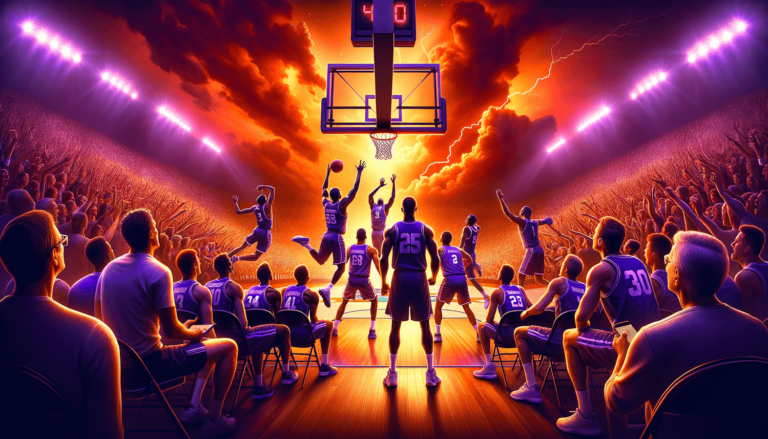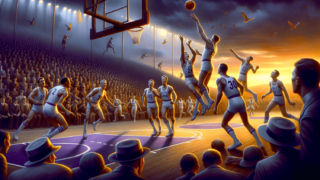
Most Memorable March Madness Moments
Written by: Basketball Universe
Last updated:

March Madness is synonymous with heart-stopping drama and the thrill of victorious underdogs. Every year, basketball fans around the globe are captivated by the NCAA Tournament, which promises unforgettable moments and high-octane action. As we embark on a journey down memory lane, prepare for your pulse to quicken as we recount the most memorable moments in the illustrious history of March Madness. Buckle up for buzzer-beaters, unforeseen upsets, and iconic performances that will keep you on the edge of your seat, eager for more college basketball magic that has etched its mark in the annals of sports history.
Most Memorable March Madness Moments
There are certainly numerous unforgettable moments in March Madness history, but some of the most memorable ones include NC State’s last-second layup to defeat Houston in the 1983 championship game, the Michigan “Fab Five” making it to back-to-back championship games in 1992 and 1993, Christian Laettner’s iconic buzzer-beater in 1992 for Duke, Gordon Hayward’s almost game-winning shot for underdog Butler in 2010, and UMBC becoming the first 16-seed team to defeat a 1-seed (Virginia) in 2018. These extraordinary moments have captivated fans and cemented the NCAA Tournament’s reputation for unmatched excitement and drama.
NC State’s 1983 Championship Game Upset
In 1983, the NC State Wolfpack entered the NCAA Tournament with a relatively modest 17-10 record but surged through the postseason with newfound vigor. Under the guidance of legendary coach Jim Valvano, NC State pulled off one of the most memorable upsets in basketball history, defeating the top-ranked Houston Cougars in the championship game.
The Underdog Wolfpack Defies Expectations
The 1983 championship game featured the sixth-seeded Wolfpack going up against the powerhouse Houston Cougars, nicknamed “Phi Slama Jama” for their athletic dunking prowess led by stars Clyde Drexler and Hakeem Olajuwon. With the odds seemingly insurmountable, NC State managed to keep the game close, setting the stage for a thrilling finish.
Lorenzo Charles’ Game-Winning Putback
With mere seconds remaining, NC State’s Dereck Whittenburg heaved a desperation shot from beyond the arc, only for Lorenzo Charles to catch the airball in mid-air and dunk it home as time expired. The image of Charles holding the ball and Valvano storming the court has become one of the most iconic in college basketball history.
Michigan’s “Fab Five” Emergence
The 1991-1992 and 1992-1993 seasons saw the unprecedented rise of the “Fab Five,” a cohort of supremely talented freshmen players who took the college basketball world by storm. This remarkable group consisted of Chris Webber, Jalen Rose, Juwan Howard, Jimmy King, and Ray Jackson, who together guided the University of Michigan Wolverines to back-to-back NCAA championship game appearances.
Impact on College Basketball
Their flashy on-court style and undeniable talent had an indelible impact on the sport. The Fab Five brought a new level of swagger and finesse to college basketball, inspiring a generation of young athletes to wear baggy shorts, black socks and redefine the game.
The Infamous Time-Out Incident
Despite their undeniable success, the Fab Five’s legacy was marred by a critical error in the closing moments of the 1993 championship game. Trailing by two, Webber called an illegal time-out that resulted in a technical foul and ultimately led to Michigan’s defeat. Despite this error, the “Fab Five” remains one of the most influential and memorable squads in basketball history, pioneering a new era of college basketball culture and style.
Christian Laettner’s Buzzer-Beating Drama
In the 1992 NCAA Tournament, Duke University faced its biggest rival, the University of Kentucky Wildcats, in a thrilling regional final game that would go down as one of the greatest in March Madness history.
Laettner’s Perfect Game
Duke’s Christian Laettner played a monumental role in this legendary showdown. The star forward shot a perfect 10-for-10 from the field and made all ten of his free throw attempts, showcasing his incredible skill and determination under the brightest of lights. His shining moment, however, would come in the dying seconds of the game.
The Shot Heard Around the World
With only 2.1 seconds remaining in overtime and Duke trailing by one, Laettner received Grant Hill’s full-court pass at the free-throw line. With a single dribble and turnaround jumper, Laettner sank the buzzer-beater, sending Duke to the Final Four and cementing his place in college basketball history. This moment not only demonstrated the high stakes and excitement inherent in March Madness but also solidified Laettner’s place among college basketball’s elite.
Butler’s Near-Miss Against Duke
The 2010 NCAA Tournament Championship game between the Butler Bulldogs and the Duke Blue Devils was a classic David versus Goliath matchup. As a fifth-seeded, mid-major team from Indianapolis, few expected Butler to make a deep run into the tournament, let alone challenge for the national championship.
Butler’s Improbable Run
Guided by the unflappable Gordon Hayward and energetic coach Brad Stevens, the Butler Bulldogs defied the odds and entered the 2010 NCAA Championship game. Facing the juggernaut Duke Blue Devils, coached by the storied Mike Krzyzewski, the Bulldogs fought valiantly, keeping the game close from tip-off to the final buzzer.
The Almost Miracle
In the closing seconds, with Duke leading by two, Hayward launched a last-ditch, half-court shot that narrowly missed the mark, bouncing off the rim and leaving the Bulldogs just short of a remarkable, unexpected victory. Despite the devastating outcome for Butler, the game served as a defining moment in the narrative of the Butler Bulldogs’ program and a testament to the drama that has become synonymous with March Madness.
UMBC’s Historic Upset Over Virginia
The University of Maryland, Baltimore County (UMBC) Retrievers entered the 2018 NCAA Tournament as one of the lowest-seeded teams, facing off against the tournament’s top seed, the University of Virginia Cavaliers. Nobody saw the potential for an historic upset, as no 16-seed team had ever defeated a 1-seed in the history of the tournament, but the resilient Retrievers had other plans.
Defying the Odds
Despite the challenging matchup, UMBC played confidently, led by an inspiring performance from guard Jairus Lyles who scored 28 points against the nation’s top-ranked defense. The underdog Retrievers managed to not only defeat Virginia but do so in a stunning 20-point rout – a moment that will forever be remembered in March Madness lore.
The Legacy of the Upset
As the first 16-seed to ever defeat a 1-seed, UMBC and their remarkable victory represent everything that makes March Madness so captivating: the unpredictability, the unrelenting determination, and the chance for the unlikeliest of heroes to etch their names in basketball history. The upset serves as a reminder that, in March Madness, anything can happen, and no team can be counted out.
Valparaiso’s Bryce Drew Game-Winner
In the first round of the 1998 NCAA Tournament, Valparaiso, a modest 13-seed, faced the 4-seed Ole Miss Rebels in a tightly contested matchup. With time running short and Valparaiso trailing by two, Coach Homer Drew called a play that would be remembered as the “Pacer,” which was designed to create a three-point shot opportunity in the final seconds.
Bryce Drew’s Improbable Buzzer-Beater
After an accurate inbounds pass, the ball found its way to Bryce Drew, the coach’s son, at the top of the arc. Drew released a stunning three-pointer just as time expired, scoring the game-winning shot and lifting the Crusaders to a shocking 70-69 upset of Ole Miss. The improbable finish is an iconic March Madness moment that captivated the sporting world, and showed once again that the underdog can never be underestimated during the NCAA Tournament.
George Mason’s 2006 Cinderella Run
The 2006 NCAA Tournament introduced college basketball fans to the ultimate Cinderella story in the form of the 11th-seeded George Mason Patriots. Expertly coached by Jim Larranaga, the Patriots produced an unlikely, awe-inspiring Final Four run that would be etched in the annals of basketball history.
Victory Over Powerhouses
George Mason’s magical journey through the tournament was defined by their ability to outperform powerhouse programs. The Patriots managed to knock off two top-seeded teams in the process, the Michigan State Spartans and the North Carolina Tar Heels, paving their way to an extraordinary show-stopping Elite Eight matchup against the University of Connecticut (UConn) Huskies.
An Unforgettable Upset
In their Elite Eight matchup against UConn, George Mason executed a game for the ages. In a thrilling display of perseverance, they pushed the game into overtime, and guard Lamar Butler led the charge. As the final buzzer sounded, the Patriots secured a victory, cementing their improbable place in the 2006 Final Four. Though George Mason wasn’t able to clinch the championship, their captivating underdog tale left a lasting impact on March Madness enthusiasts.
Norfolk State’s Shocking Upset over Missouri
The 2012 NCAA Tournament introduced a classic March Madness shocker when the 15-seed Norfolk State Spartans faced off against the heavily favored 2-seed Missouri Tigers. Despite being written off as a surefire first-round knockout, the Spartans played a fearless game, leaving fans across the country with bated breath.
A Dominating Performance by Kyle O’Quinn
Norfolk State Center Kyle O’Quinn’s 26-point, 14-rebound performance against the Tigers showcased his immense skill and determined spirit. As the game entered its final moments, O’Quinn’s crucial blocks and crucial late-game scoring allowed Norfolk State to take and maintain the lead against Missouri, securing a well-earned victory.
An Unforgettable 15-2 Upset
Norfolk State’s victory over Missouri in the 2012 NCAA Tournament remains one of the most unexpected upsets in March Madness history. The Spartans rose to the occasion against insurmountable odds, etching their name into NCAA basketball history, and providing fans with yet another memorable March Madness moment.
Frequently Asked Questions
When discussing March Madness and its most memorable moments, numerous questions often arise about the intricacies of the tournament, legendary upsets, and unforgettable basketball dynasties. This FAQ section is dedicated to answering some of the most common questions that enthusiasts might ask on this topic. Dive in and discover even more insights about the most captivating moments in March Madness history.
1. How does the March Madness tournament work?
March Madness, also known as the NCAA Division I Basketball Tournament, is an annual single-elimination tournament consisting of 68 college basketball teams. The tournament is divided into four regions of 16 teams each, seeded from 1 to 16 based on regular-season performance. Teams advance through the bracket by winning successive games and the final four remaining teams in each region face off in a national semifinal, with the winners competing for the championship.
2. How did the term “March Madness” originate?
The term “March Madness” was first used in reference to basketball by Henry V. Porter in his essay “March Madness” from an Illinois high school basketball association magazine. However, it was infused into college basketball vernacular when sportscaster Brent Musburger used it during coverage of the 1982 NCAA Tournament. The phrase encapsulates the excitement, unpredictability, and sheer scale of the event that takes place each year in March.
3. How have 16-seed teams fared against 1-seed teams?
Historically, 16-seed teams have rarely succeeded against 1-seed teams. It took 135 attempts over a span of 33 years for a 16-seed to finally emerge victorious against a 1-seed. In 2018, the UMBC Retrievers made history when they beat the Virginia Cavaliers, making this the first and only time a 16-seed has defeated a 1-seed in the NCAA Tournament. The odds are typically heavily stacked against the lowest seeds facing the tournament’s top-seeded contenders.
4. Are there other notable 15-vs.-2 upsets besides Norfolk State?
Yes, there have been several other instances where a 15-seed upset a 2-seed in the NCAA Tournament. Notable occurrences include Richmond defeating Syracuse (1991), Santa Clara defeating Arizona (1993), Coppin State defeating South Carolina (1997), Hampton defeating Iowa State (2001), Lehigh defeating Duke (2012), and Florida Gulf Coast defeating Georgetown (2013). While still rare, 15-vs.-2 upsets are more common than 16-vs.-1 upsets.
5. Who holds the record for most NCAA Tournament championships?
The University of California, Los Angeles (UCLA) holds the record for the most NCAA Tournament championships in college basketball history, with 11 titles to their name. During the late 1960s and early 1970s, UCLA was a dominant force under legendary coach John Wooden, contributing to the program’s unmatched success.
6. What is the lowest seed to win the NCAA Tournament?
The lowest seed to ever capture the NCAA Tournament’s ultimate prize was the Villanova Wildcats in 1985. As an 8-seed, Villanova defeated the heavily favored Georgetown Hoyas (a 1-seed) in the championship game, capping off a remarkable and unlikely championship run.
7. Which college has made the most Final Four appearances?
With 20 Final Four appearances to their name, the North Carolina Tar Heels hold the record for the most trips to the Final Four. The Tar Heels have a rich basketball history, producing numerous NBA stars and winning six national championships under the guidance of Hall of Fame coaches Dean Smith and Roy Williams.
8. How do “Cinderella stories” impact the fan-favorite aspect of March Madness?
“Cinderella stories” refer to the improbable and unexpected success of underdog teams during the NCAA Tournament. These inspiring runs often capture the imagination of fans, who relish the unpredictable nature of the tournament and love to see lower-ranked teams defy the odds and topple their highly-rated adversaries. Cinderella stories remind fans that anything is possible in college basketball, and these unexpected triumphs only add to the allure and excitement of March Madness.
9. Who are some of the most well-known college basketball coaches associated with March Madness?
Some of the most recognizable college basketball coaches associated with March Madness success include John Wooden (UCLA), Mike Krzyzewski (Duke), Dean Smith (North Carolina), Jim
Featured Posts
- No pillar pages found.





